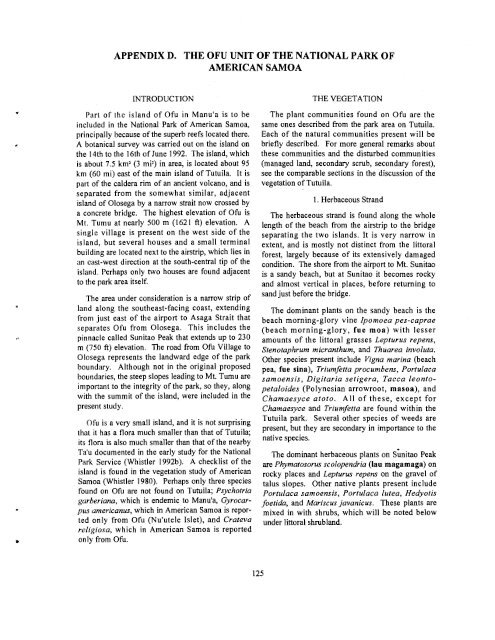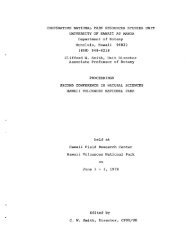american samoa - University of Hawaii at Manoa
american samoa - University of Hawaii at Manoa
american samoa - University of Hawaii at Manoa
You also want an ePaper? Increase the reach of your titles
YUMPU automatically turns print PDFs into web optimized ePapers that Google loves.
APPENDIX D. THE OFU UNIT OF THE NATIONAL PARK OF<br />
AMERICAN SAMOA<br />
INTRODUCTION<br />
Part <strong>of</strong> the island <strong>of</strong> Ofu in Manu'a is to be<br />
included in the N<strong>at</strong>ional Park <strong>of</strong> American Samoa,<br />
principally because <strong>of</strong> the superb reefs loc<strong>at</strong>ed there.<br />
A botanical survey was carried out on the island on<br />
the 14th to the 16th <strong>of</strong> June 1992. The island, which<br />
is about 7.5 km2 (3 mi2) in area, is loc<strong>at</strong>ed about 95<br />
km (60 mi) east <strong>of</strong> the main island <strong>of</strong> Tutuila. It is<br />
part <strong>of</strong> the caldera rim <strong>of</strong> an ancient volcano, and is<br />
separ<strong>at</strong>ed from the somewh<strong>at</strong> similar, adjacent<br />
island <strong>of</strong> Olosega by a narrow strait now crossed by<br />
a concrete bridge. The highest elev<strong>at</strong>ion <strong>of</strong> Ofu is<br />
Mt. Tumu <strong>at</strong> nearly 500 m (1621 ft) elev<strong>at</strong>ion. A<br />
single village is present on the west side <strong>of</strong> the<br />
island, but several houses and a small terminal<br />
building are loc<strong>at</strong>ed next to the airstrip, which lies in<br />
an east-west direction <strong>at</strong> the south-central tip <strong>of</strong> the<br />
island. Perhaps only two houses are found adjacent<br />
to the park area itself.<br />
The area under consider<strong>at</strong>ion is a narrow strip <strong>of</strong><br />
land along the southeast-facing coast, extending<br />
from just east <strong>of</strong> the airport to Asaga Strait th<strong>at</strong><br />
separ<strong>at</strong>es Ofu from Olosega. This includes the<br />
pinnacle called Sunitao Peak th<strong>at</strong> extends up to 230<br />
m (750 ft) elev<strong>at</strong>ion. The road from O h Village to<br />
Olosega represents the landward edge <strong>of</strong> the park<br />
boundary. Although not in the original proposed<br />
boundaries, the steep slopes leading to Mt. Tumu are<br />
important to the integrity <strong>of</strong> the park, so they, along<br />
with the summit <strong>of</strong> the island, were included in the<br />
present study.<br />
Ofu is a very small island, and it is not surprising<br />
th<strong>at</strong> it has a flora much smaller than th<strong>at</strong> <strong>of</strong> Tutuila;<br />
its flora is also much smaller than th<strong>at</strong> <strong>of</strong> the nearby<br />
Ta'u documented in the early study for the N<strong>at</strong>ional<br />
Park Service (Whistler 1992b). A checklist <strong>of</strong> the<br />
island is found in the veget<strong>at</strong>ion study <strong>of</strong> American<br />
Samoa (Whistler 1980). Perhaps only three species<br />
found on Ofu are not found on Tutuila; Psychotria<br />
garberiana, which is endemic to Manu'a, Gyrocar-<br />
pus <strong>american</strong>us, which in American Samoa is repor-<br />
ted only from Ofu (Nu'utele Islet), and Cr<strong>at</strong>eva<br />
religiosa, which in American Samoa is reported<br />
only from Ofu.<br />
THE VEGETATION<br />
The plant communities found on Ofu are the<br />
same ones described from the park area on Tutuila.<br />
Each <strong>of</strong> the n<strong>at</strong>ural communities present will be<br />
briefly described. For more general remarks about<br />
these communities and the disturbed communities<br />
(managed land, secondary scrub, secondary forest),<br />
see the comparable sections in the discussion <strong>of</strong> the<br />
veget<strong>at</strong>ion <strong>of</strong> Tutuila.<br />
1. Herbaceous Strand<br />
The herbaceous strand is found along the whole<br />
length <strong>of</strong> the beach from the airstrip to the bridge<br />
separ<strong>at</strong>ing the two islands. It is very narrow in<br />
extent, and is mostly not distinct from the littoral<br />
forest, largely because <strong>of</strong> its extensively damaged<br />
condition. The shore from the airport to Mt. Sunitao<br />
is a sandy beach, but <strong>at</strong> Sunitao it becomes rocky<br />
and almost vertical in places, before returning to<br />
sand just before the bridge.<br />
The dominant plants on the sandy beach is the<br />
beach morning-glory vine Ipomoea pes-caprae<br />
(beach morning-glory, fue moa) with lesser<br />
amounts <strong>of</strong> the littoral grasses Lepturus repens,<br />
Stenotaphrum micranthum, and Thuarea involuta.<br />
Other species present include Vigna marina (beach<br />
pea, fue sina), Triumfetta procumbens, Portulaca<br />
samoensis, Digitaria setigera, Tacca leonto-<br />
petaloides (Polynesian arrowroot, masoa), and<br />
Chamaesyce <strong>at</strong>oto. All <strong>of</strong> these, except for<br />
Chamaesyce and Triumfetta are found within the<br />
Tutuila park. Several other species <strong>of</strong> weeds are<br />
present, but they are secondary in importance to the<br />
n<strong>at</strong>ive species.<br />
The dominant herbaceous plants on ~initao<br />
Peak<br />
are Phym<strong>at</strong>osorus scolopendria (lau magamaga) on<br />
rocky places and Lepturus repens on the gravel <strong>of</strong><br />
talus slopes. Other n<strong>at</strong>ive plants present include<br />
Portulaca samoensis, Portulaca lutea, Hedyotis<br />
foetida, and Mariscus javanicus. These plants are<br />
mixed in with shrubs, which will be noted below<br />
under littoral shrubland.
















